This post originally appeared on Murder Is Everywhere.
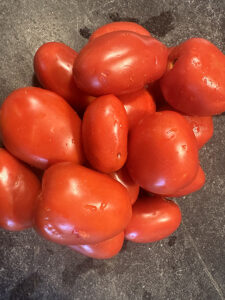
It’s entirely possible to buy tomatoes in many parts of the world without being able to speak the language. In Spanish and German, it’s called a tomate. In Hindi, they say tamaatar, and in Gujarati, tamota. In Turkish, domades.
There seems to be one theme emerging, but there’s a second linguistic direction followed by those who speak romance languages. The French named the tomato pomme d’amour (love apple). The aphrodisiac philosphy carries over to the name pomidor in Russian and pomodoro in Italian.
I was born in England so I used to say toe-mah-toe, but now that I’m in the US it’s toe-may-toe. Doesn’t sound as romantic, but I do believe tomatoes are the binder of happy meals and marriages.
Last Sunday, my husband Tony and I agreed it would be a good idea to buy 30 pounds of Roma tomatoes at the farmers market in order to stock up for the fall and winter.
I actually only needed about five pounds of tomatoes to make a highly spiced Indian tomato chutney.
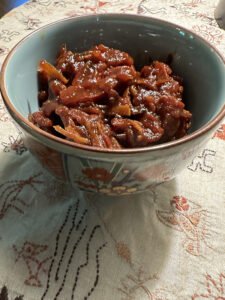
On the other hand, Tony needed a huge amount. He wanted to make a few gallons of a pureed tomato, garlic and onion sauce that could be a base for many dishes. He’s been making this sauce for us for years and ensures a good store for most of the year by carefully pouring 2-cup quantities and freezing them. But now that he’s got his own vacuum-sealing equipment, he could do it in air-tight blocks to be stored in our large standing freezer (another recent husband purchase).
I don’t know if you are getting the dynamic of our 31-year-marriage yet, but it involves what you might call differences of opinion.
Two people, two tomato-buying expeditions ensued. On a Friday, I bought 5 pounds of Roma tomatoes from a roadside farm stand. On Sunday, when we went to the Baltimore Farmers Market, where I found the only farmer selling bushels and larger of tomatoes, including Romas, which everyone knows are the preferred sauce-making tomato due to their lower level of water content. I paid for the beauties, and Tony lugged a 25-lb cardboard box packed with Romas to our car. When he got home, he located the cotton gloves he’d wear under vinyl gloves to protect his hands from slipper tomato juice, and he located the vacuum sealing machine and roll of heavy-duty freezer plastic. The knives came out, and operation tomato sauce was underway.
At the start of marriage in our twenties, I’d have been at Tony’s side helping him blanch a few hundred Roma tomatoes in lightly simmering water, and then deseed, as well as the eye-watering task of chopping onions. But Tony’s cooking style is longer and more perfectionist than mine, so I’ve leave him to cook some dishes undisturbed.
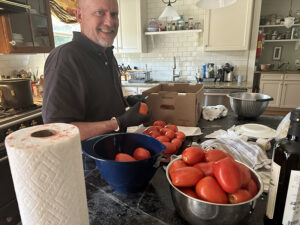
When his sauce was on its first simmer (yes, it gets cooked twice!) and all his rigamarole was in the dishwasher, I returned to the kitchen to start prepping. My recipe was a lot simpler, and I had many fewer tomatoes to chop. Still, I had to do some math to calculate the right amount of vinegar and sugar and garlic and ginger to use. Just slivering the fresh ginger and garlic took me an hour and a half.
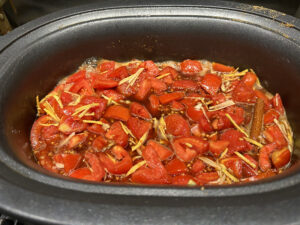
I am always looking for shortcuts, so I decided to try simmering my chutney in a slow cooker. After a night’s cooking on low, I was disappointed that the temperature was just a bit too low for the chutney to thicken. So, I poured the warm mixture of tomatoes, spices and vinegar into a ceramic-coated Dutch oven, and after I brought it to ha happy boil, I lowered the temperature to simmer and partially covered the pot. About four hours later, the red chunks swimming in vinegar had reduced by half into a rich reddish brown, sticky concoction. I added just a tiny bit more sugar and salt to taste, and the chutney was ready to cool in the fridge.
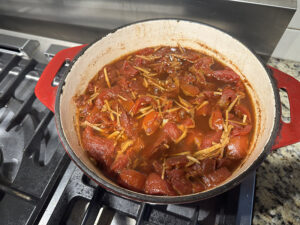
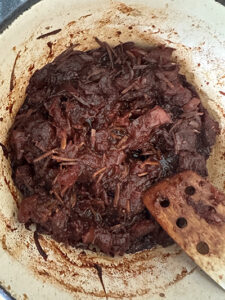
At the end of our tomato weekend, the kitchen smelled of vinegar and garlic, and we were happily exhausted. Both tomato recipes are listed on my website. Tony’s sauce is European, and my chutney is Indian, but we are united as a couple who will share these savory tastes over the upcoming six months.
Here’s what one can do with a simple tomato-onion-garlic sauce:
- Add Italian herbs and make a marinara sauce
- Add ground meat and make it a ragu
- Add cumin and chilies and other ingredients to make a Middle Eastern, Mexican or Indian gravy to blanket a baked dish or curry
- Add milk or cream to make cream of tomato soup
Here are some ways to use a tomato chutney:
- Serve it as an accompaniment to a classic Indian meal
- Add it to a cheese, vegetable or chicken sandwich
- Serve it with grilled meat or fish
- Peel hardboiled eggs, split them, and put a dash of chutney down the middle
Bon Appetit!
